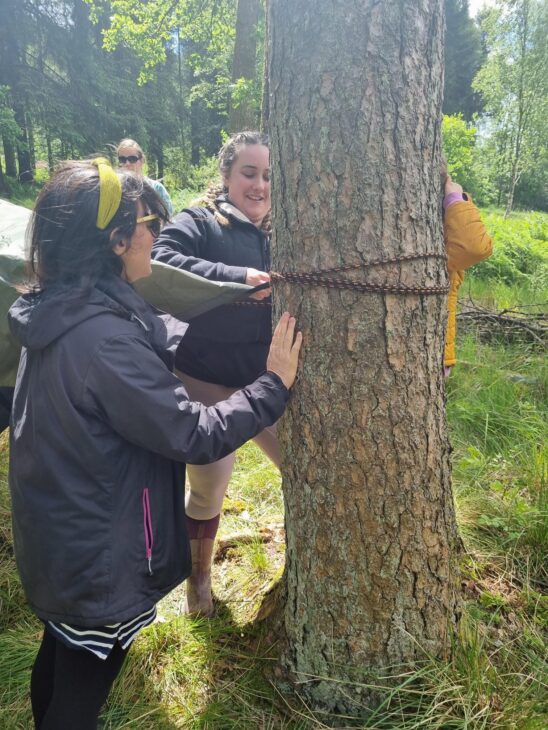Teaching the teachers of tomorrow
,
Despite the pandemic, over the past four years of the project, we have been fortunate to work with many schools in the Cumbernauld area. During this time, we have delivered both Early Connections and Natural Connections sessions for pupils and teachers – in both Primary and Secondary schools – across Cumbernauld.
The pandemic has made us ever more aware of the how valuable nature has been to the physical – as well as mental health and wellbeing of children. Fortunately, schools have responded by increasingly looking to find ways to make outdoor learning a priority.
As we move towards the fifth year of the project – and also the midway point of the year, it feels like a good time to reflect on what we have learned from our experiences of delivering outdoor learning to schools. It goes without saying that it has been endlessly beneficial to young people – in terms of raising awareness of the importance of our native habitats – through creating memorable interactions with nature and wildlife. But what has become increasingly clear are the ‘limiting factors’ – or the barriers to access and what stands in the way of sustained access to green spaces.
One immediately evident barrier to memorable experiential outdoor learning is that school sites are often dominated by concrete – and so are lacking the diverse native habitats needed for rich outdoor learning experiences. Another limiting factor is how young people access Cumbernauld’s green spaces in the first place. In an era of almost all parents having to work full-time, young people are often reliant on access beginning and being embedded at school. This is only ever possible if teachers are prepared – and indeed confident enough to take pupils to sites where nature is on show – on a regular basis.
Many can attest to the role that teachers play in influencing the trajectory of our lives. Never was this role more powerful than it is right now. In the words of David Attenborough: “no one will protect what they don’t care about; and no one will care about what they have never experienced”. Making sure young people spend quality time in our local green spaces – like our SWT nature reserves – is a critical factor in addressing the climate crisis. Teachers really do have an undisputed power to make sure young people have experiences in their local green spaces – which will help young people develop a love of – as well as a drive to protect – nature.
So it was with this vital role of teachers in mind that we have been spending the first half of this year ramping up our efforts to deliver CPD (Continuing Professional Development) to local teachers (from both primary and secondary schools). This culminated in a day-long CPD day for trainee teachers at SWT Seafar Woods Nature reserve – which took place on Friday 10th June 2022. The Cumbernauld Living Landscape Team welcomed almost 30 trainee Teachers to the Living Landscape of Seafar Woods: on what was a very typically mixed-weather day. This was ideal and actually just what we had been hoping for! The wide range of all-weather activities planned for teachers to experience and have a go at – were especially designed to help them overcome any weather-related anxiety about taking learning outside.
The CPD day began with a litter pick led by Katie Brown, our Unlocking Community Capacity project officer. Katie was keen to explain how vital an environmental action this is as a task to carry out with young people – not just at landscape scale, but in terms of it preventing micro plastics at sea-scale.
Living Landscapes Programme Manager, Cathleen Thomas delivered three outdoor skills sessions – on knot tying, shelter building and hammock rigging. Cathleen conveyed how it is possible to tie activities like building man made shelters in with the ‘leave no trace’ principle – as deadwood shelters inevitably cause a habitat disturbance issue for invertebrates. The trainee teachers clearly enjoyed the experience as much as Cathleen:

The CPD event also saw Paul Barclay, our Health and Wellbeing project officer, lead a ‘Wild Ways Well’ session. The trainee teachers were treated to a wildlife walk – where they did tree identification, as well as ‘Five Ways to Wellbeing’ activities and several mindful experiences. Katie Brown delivered inspiring sessions on numeracy – which allowed the trainee teachers to learn fun and innovative ways to work out a trees age – as well as its height. The weather also gave her the opportunity to share her wonderful rain gauge activity with the groups. Holly Owens also joined the CLL team from the Scottish Wildlife Trust in Edinburgh – to deliver her engaging sessions on Feeling Safe Outdoors. These covered risk assessing as well as understanding the Scottish Outdoor Access Code and how this can be seen as enabling rather than restrictive.
This experiential learning day was designed to be a fully immersive opportunity for the teachers to step into the role of the learner. It provided an opportunity not only to learn new skills and activities to connect their future pupils to nature, but to witness how spending quality time in a wonderful wooded setting like Seafar Woods can be awe-inspiring.

Teaching teachers in this way – who then cascade the information throughout their school – is an ideal way to make sure the baton of experiential outdoor learning is passed on. Looking ahead to the next year of the project, working with teachers in this way is about future proofing our outdoor education offering. To leave a meaningful legacy, we know we need to empower teachers. Indeed – it is one of the best ways we can make sure our project has ‘legs’.

